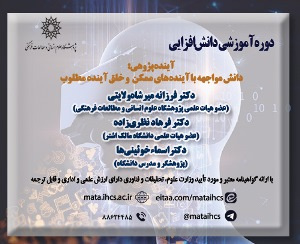تحلیل علم سنجی از مقالات آینده پژوهی منتشر شده در نشریات علمی ایران (مقاله علمی وزارت علوم)
درجه علمی: نشریه علمی (وزارت علوم)
آرشیو
چکیده
درک سرشت پژوهش های یک حوزه ی دانشگاهی و رفتار پژوهشگران در آن حوزه، به خصوص در مورد مقولات میان رشته ای بسیار مهم است. درک حاصله به برنامه ریزان و پژوهشگران کمک می کند تا ضمن فهم وضعیت گذشته و حال، برای بهبود وضعیت آینده نقشه راه دقیق تری داشته باشند. این مهم در مورد آینده پژوهی نیز صادق است به خصوص اینکه آینده پژوهی ذاتاَ در مورد وضعیت آینده است و فهم گذشته و حال آن نشان می دهد که به کدام آینده ها بیشتر پرداخته ایم و از کدام آینده ها غفلت کرده ایم. برای رسیدن به این درک به مطالعات علم سنجی نیاز است که در این پژوهش به منظور تحلیل مقالات آینده پژوهی منتشر شده در نشریات علمی ایران از ابزارهای آن استفاده شد. جامعه این تحقیق تعداد 920 مقاله منتشر شده در حوزه آینده پژوهی بود. نتایج نشان داد که شبکه هم نویسندگی بر اساس سنجه های مرکزیت به چه شکل است. همچنین هشت خوشه موضوعی در این زمینه شناسایی شدند و جایگاه آنها در نمودار راهبردی مشخص گردید. خوشه "جغرافیدان های عاشق آینده" به عنوان خوشه ی با مرکزیت و تراکم بالا مشخص شد. همچنین خوشه های "آینده نگاری راهبردی" و " آموزش عالی آینده گرا" به عنوان خوشه های نابالغ و توسعه نایافته معرفی شدند. خوشه های "توسعه دانشی"، "آینده دینی"، "روابط منطقه ای" و "وزن سنگین روش" در منطقه افول و نوظهور قرار گرفتند و خوشه ی "چشم انداز آی سی تی" به عنوان خوشه غیر محوری شناخته شد.Scientometric analysis of futures studies articles published in Iranian scientific journals.
It is very important to understand the nature of research in an academic field and the behavior of researchers in that field, especially in the case of interdisciplinary categories. The resulting understanding helps planners and researchers to have a more accurate road map to improve the future situation while understanding the past and present situation. This is also true for futures studies, especially since futures studies is inherently about the future situation, and understanding the past and its present shows which futures we have paid more attention to and which futures we have neglected. To reach this understanding, scientometric studies are needed, and in this research, its tools were used to analyze futures studies articles published in Iranian scientific journals. The population of this research was 920 articles published in the field of futures studies. The results showed what the co-authorship network looks like based on the centrality measures. Also, eight topic clusters were identified in this field and their position in the strategic diagram was determined. "Geographers in love with the future" cluster was identified as a cluster with high centrality and density. Also, "strategic foresight" and "futuristic higher education" clusters were introduced as immature and underdeveloped clusters. "Knowledge development", "Religious future", "Regional relations" and "Heavy weight of method" clusters were placed in the declining and emerging region, and the "ICT perspective" cluster was recognized as a non-core cluster.




